Translate this page into:
Role of handedness in flying performance
Abstract
Handedness as an attribute has been vastly studied in particular professions where this attribute does play a major role. In aviation, early studies did show some promising results in the form of identifying this attribute as a possible predictor of flying performance but none presented a consolidated evidence for establishing this fact. There has also been no study on the incidence and role of handedness among aviators in the Indian Armed Forces. This study was conducted to assess the hand dexterity over controls amongst left and right-handed aircrew in conventional cockpits. Twenty healthy individuals in the age group of 20-39 yrs (30±4 yrs) volunteered for the study. Based on their self-reported handedness and being either a pilot or a non-pilot, they were placed in four groups. Each group had five subjects. The subjects filled the Edinburgh handedness questionnaire and then carried out three tests in sequence - Two Hand Coordination Test, MRMT (Minnesota Rate of Manipulation Test) Board Test and Finger Dexterity Board Test A survey of handedness was also carried out using a questionnaire in a section of pilots. The survey was conducted at four Air Force stations and also, amongst the pilots reporting at Medical Evaluation Centre (MEC) at I AM. Total of257 questionnaires were completed and analyzed. The results revealed that in two-hand coordination and eye-hand coordination tasks and also in hand dexterity tasks the left-handed aircrew was not at a disadvantage. This favoured the view that there was no bias against left-handers in the conventional cockpit. The handedness survey revealed that the incidence of the left-handers in aviators w as the same as that in the general population strengthening the view that there is no bias against the left-hander in flying selection or training. A spectrum of laterality was observed and the relative incidence of mixed handedness was found to be more in the left-handed. There was no difference in the two-hand coordination task and performance of eye-hand and arm-hand coordinated tasks that mimicked the operation of the primary controls between the left and right-handed pilot. The high relative incidence of mixed-handedness in the left-handers shows the high degree of adaptability of the left-handers in a world “apparently designed” for the right-handers.
Keywords
Handedness
aviators
laterality quotient
Handedness as an attribute has been vastly studied throughout the world by psychologists. In many of the professions this attribute does play a major role, significant enough to modify the use of tools on the basis of the use of preferred hand. It is quite natural to design tools and machinery for the use by majority, the basic principle of human factors. In specialized areas where the manual dexterity could play a role, the user defined designing takes precedence hence development of either tools requiring no hand preference or custom made for the right or the left handed. In aviation a few early studies by Norwegian and American workers did show some promising results in form of identifying this attribute as a possible predictor of flying performances but none presented a consolidated data or proof for establishing this fact [1,2]. Whether the conventional controls in an aircraft cockpit, by design or default present an advantage to right handed, who are unquestionably in a majority vis-à-vis the left handed remains an area worth looking into. In aviation, it is felt that in the location and design of controls, the handedness of operators has not been taken into consideration by the designers. Crowley & McAnulty [2] have opined that the incidental mentions of handedness in aeromedical literature stem from the general feeling that “a healthy, motivated left hander will simply learn to use his right hand to fly”! Piloting an aircraft requires a high degree of perceptive, cognitive and motor ability to react appropriately to a changing environment and situation. That handedness may have a role in determining the level of proficiency that a pilot can acquire has not been studied or looked into in the past. It has been speculated that left-handed pilots might be at a disadvantage as compared to their right-handed peers. It has also been suggested that, the strength of the lateral preference may correlate with performance in the cockpit. In the Indian Air Force, information about the physique and psyche of the potential aviator at the time of entry is comprehensively assessed and documented. However, handedness has not been considered. The aim in this study was to assess the role and effect of handedness in flying performance in conditions that would simulate cockpit controls and to find the differences, if any, in hand dexterity, between left and right-handed individuals.
Material and Methods
A total of 20 healthy male individuals in the age group of 20-39 yrs (30±4 yrs) volunteered for the study. Based on their self-reported handedness and being either a pilot (P) or a non-pilot (NP), they were placed in four groups; right-handed pilots, right-handed non-pilots, left-handed pilots and left-handed non-pilots. Each group had five subjects. The pilots were both, military and civil aviators with more than 450 hrs of flying experience. None of the volunteers had any compromise in their cognitive and motor performance. All had a fair knowledge and proficiency in operating computers.
Protocol
The four groups of subjects first filled the Edinburgh handedness questionnaire and then carried out three tests in sequence - Two Hand Coordination Test, MRMT (Minnesota Rate of Manipulation Test) Board Test and Finger Dexterity Board Test. These tests were carried out, between 1400- 1700h, in a quiet room, in the Human Engineering Department at Institute of Aerospace Medicine (IAM), Bangalore. Detailed instructions to understand the protocol were given to the subjects before the commencement of the test.
Two Hand Coordination Test.
The Two-Hand Coordination Test was carried out by all the subjects in the four groups on the Psychomotor Rig. The controls presented were akin to the central control column and throttle lever in the conventional cockpits.
MRMT (Minnesota Rate of Manipulation Test).
The MRMT board was used for testing eye-hand coordination and arm-hand dexterity. The time to complete this procedure successfully was noted with the help of a digital stopwatch. Subject performed this procedure four times with his dominant hand followed by four times with the other hand. The time score of each successful completion was noted. Eight time scores were obtained for each subject.
Finger Dexterity Test.
The Finger Dexterity Test consisted of placing the pins in the holes. The procedure was carried out twice with the dominant hand and then twice with the other hand. The time score of each procedure was noted. Four time scores were obtained for each subject.
Handedness Survey.
Survey of handedness was carried out in a section of pilots. The survey was conducted at four Air Force stations and also, amongst the pilots reporting at Medical Evaluation Centre (MEC) at IAM. The survey was carried out using a questionnaire, adapted from the Edinburgh Handedness Inventory [3]. 200 questionnaires were distributed at the Air Force Stations and 240 in the MEC. 131 questionnaire responses were obtained from the AF Stations and 126 from the MEC. All the responses were complete, and this total of 257 was compiled for analysis.
Calculation of Laterality Quotient
Formula to calculate the laterality quotient is :
Laterality Quotient = [(R-L)/(R+L+E)] X 100
where ‘R’ & ‘L’ in this formula stand for the number of responses indicating use of ‘Right’ or ‘Left’ hand for that particular activity and Έ’ for no preference. The laterality quotient was obtained in the range of -100 to +100. Laterality scores between -75 and -100 denoted extreme left-handedness and that between +75 and +100 denoted extreme right-handedness. Individuals falling in these ranges are considered as highly lateralized. The middle range of +74 to -74 was taken to denote mixed handedness.
Statistical analysis.
The raw data from all the three tests were tabulated and subjected to statistical analyses. The data was tested for being a normal distribution by the Shapiro Wilk’s W test. As it was not found to be a normal distribution, the non-parametric Wilcoxon Matched Pairs Test was used as the test for significance in the difference between the means. The significance level was accepted at p<0.05 and values were considered to be highly significant at p<0.01.
Results
The PMT scores of the Two-hand Coordination test for the four groups are presented in Tables 1.1-1.4 and graphically depicted in Figure 1. The difference in the mean PMT scores between the right-handed and left-handed pilots, and also between the right-handed and left-handed non-pilot groups was not found to be statistically significant. The difference in the mean PMT scores between the left-handed pilots and the left-handed non-pilots and also that between the right-handed pilots and the right-handed non-pilots was not found to be statistically significant (Table 4.1).
The time scores for the Minnesota Rate of Manipulation Test for the four groups are presented in Tables 2.1-2.4 and graphically depicted in Figure 2. The difference in the mean time scores between the right-handed and left-handed pilots, and also between the right-handed and left-handed non-pilot groups was not found to be statistically significant. Moreover, the difference in the mean time scores between the left-handed pilots and the left-handed non-pilots and also that between the right-handed pilots and the right-handed non-pilots was not found to be statistically significant (Table 4.2 and 4.3).
The time scores for Finger Dexterity Test are presented in Tables 3.1-3.4 and graphically depicted in Figure 3. The difference in the mean time scores between the right and left-handed pilots, in the four groups was not found to be statistically significant. The difference in the mean time scores of the same-sided hands between the four groups was not found to be statistically significant (Tables 4.4 and 4.5). The difference of the time scores of the opposite sided hands (i.e. left hand of one group with the right hand of the other group) between the four groups was not found to be statistically significant except for one combination. The difference in the mean time scores of that of the right hand of the left-handed pilot group and the right hand of the right-handed pilot group was significant at p<0.05 (Table 4.4).
Of the 257 pilots surveyed, 19 (7.74%) were left-handed, 237 (92.2 %) were right-handed and 1 (0.4%) was found to be ambidextrous laterality score=0).
3 out of 19 left-handed pilots (17.6%) were highly lateralized (Laterality Quotient -75). Right-handed pilots showed high lateralization (Laterality Quotient +75) in 185 out of 237(88.1%). Conversely, mixed handedness was present in 69 pilots (82.4% of left-handed and 21.9% of the right-handed) (Table 5)
| Subjects | PMT Ratios | |
|---|---|---|
| 1 | AS | 8.36 |
| 2 | HRD | 9.9 |
| 3 | PVD | 8.89 |
| 4 | SNJ | 7.99 |
| 5 | SM | 9.82 |
| Mean ±SD | 8.99±0.85 |
| Subjects | PMT Ratios | |
|---|---|---|
| 1 | RR | 7.68 |
| 2 | GK | 9.46 |
| 3 | NP | 9.46 |
| 4 | SMW | 7.29 |
| 5 | KAR | 8.48 |
| Mean ±SD | 8.47±0.99 |
| Subjects | PMT Ratios | |
|---|---|---|
| 1 | PS | 11.66 |
| 2 | AK | 7.23 |
| 3 | NKS | 7.63 |
| 4 | RAU | 7.53 |
| 5 | VB | 8.9 |
| Mean ±SD | 8.59±1.83 |
| Subjects | PMT Ratios | |
|---|---|---|
| 1 | KNR | 7.86 |
| 2 | ss | 6.94 |
| 3 | HMKM | 6.87 |
| 4 | SG | 5.38 |
| 5 | RP | 10.68 |
| Mean ±SD | 7.54±1.96 |
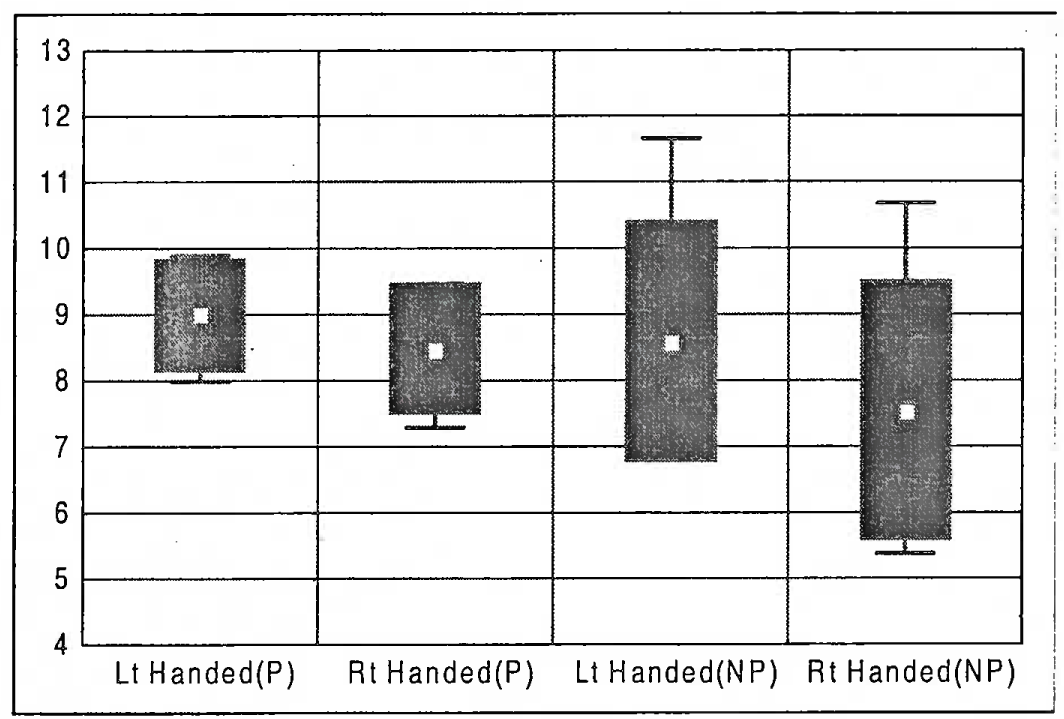
- PMT Ratios of the Subjects in the Two Hand Coordination Test
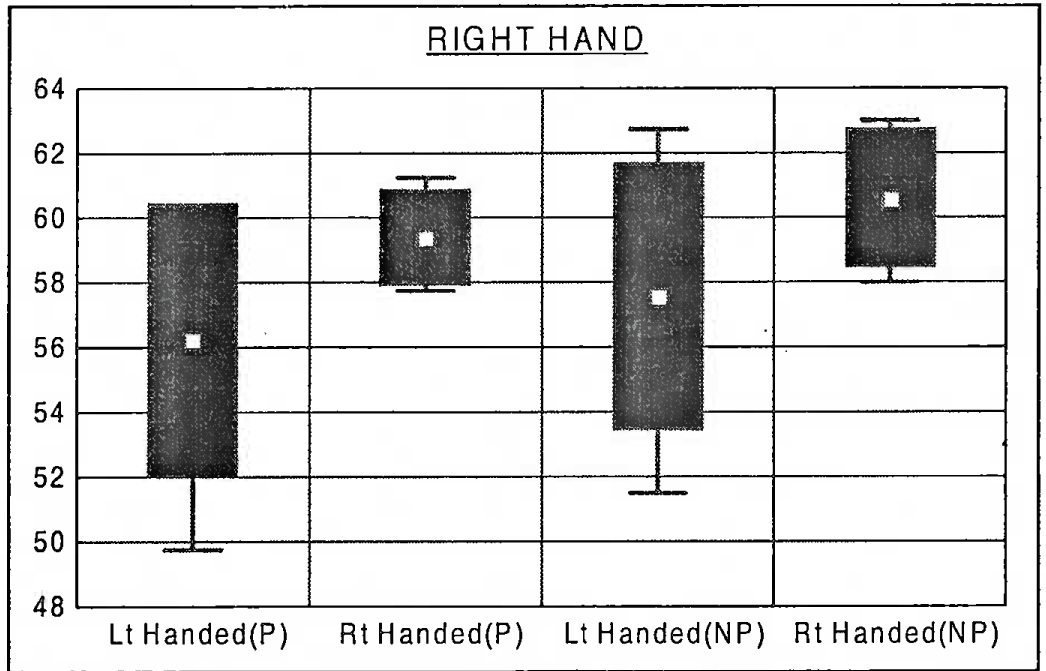
- Time score of the Subjects for Right Hand in the Minnesota Rate of Manipulation Test
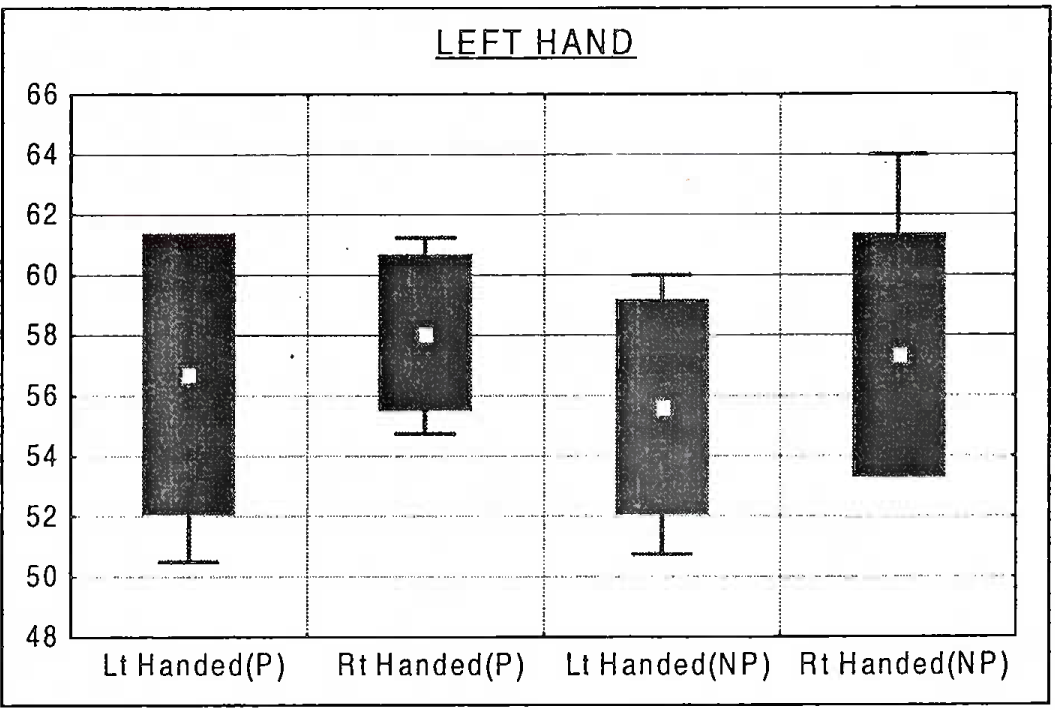
- Time score of the Subjects for Left Hand in the Minnesota Rate of Manipulaticn Test
| Attempts with Right Hand | Attempts with Left Hand | ||
|---|---|---|---|
| S No. | Subjects | Average | Average |
| 1 | AS | 58.5 | 59.75 |
| 2 | HRD | 49.75 | 50.5 |
| 3 | PVD | 60.25 | 59.5 |
| 4 | SNJ | 58.25 | 60.75 |
| 5 | SM | 54.5 | 53 |
| Mean±SD | 56.25±4.2 | 56.7±4.6 | |
| Attempts with Right Hand | Attempts with Left Hand | ||
|---|---|---|---|
| S No. | Subjects | Average | Average |
| 1 | RR | 61.25 | 61.25 |
| 2 | GK | 60 | 56.5 |
| 3 | NP | 57.75 | 54.75 |
| 4 | SMW | 60 | 58.25 |
| 5 | KAR | 58 | 59.75 |
| Mean±SD | 59.4±1.5 | 58.1±2.6 | |
| Attempts with Right Hand | Attempts with Left Hand | ||
|---|---|---|---|
| S No. | Subjects | Average | Average |
| 1 | PS | 58.75 | 57.25 |
| 2 | AK | 62.75 | 53.75 |
| 3 | NKS | 58.75 | 60 |
| 4 | RAU | 56.25 | 56.5 |
| 5 | VB | 51.5 | 50.75 |
| Mean ±SD | 57.6±4.1 | 55.6±3.5 | |
| Attempts with Right Hand | Attempts with Left Hand | ||
|---|---|---|---|
| S No. | Subjects | Average | Average |
| 1 | KNR | 60.25 | 58 |
| 2 | SS | 62.5 | 53.75 |
| 3 | HMKM | 59.25 | 55.75 |
| 4 | SG | 63 | 64 |
| 5 | RP | 58 . | 55.25 |
| Mean±SD | 60.6±2.1 | 57.3±4.0 | |
| Attempts with Right Hand | Attempts with Left Hand | ||
|---|---|---|---|
| S No. | Subjects | Average | Average |
| 1 | AS | 217 | 190 |
| 2 | HRD | 195 | 198.5 |
| 3 | PVD | 183 | 183 |
| 4 | SNJ | 188 | 190 |
| 5 | SM | 191.5 | 184 |
| Mean+SD | 194.9±13.1 | 189.1±6.2 | |
| Attempts with Right Hand | Attempts with Left Hand | ||
|---|---|---|---|
| S No. | Subjects | Average | Average |
| 1 | RR | 194.5 | 189.5 |
| 2 | GK | 183 | 189.5 |
| 3 | NP | 161.5 | 183 |
| 4 | SMW | 181 | 199.5 |
| 5 | KAR | 190.5 | 195 |
| Mean±SD | 182.1±12.8 | 191.3±6.3 | |
| Attempts with Right Hand | Attempts with Left Hand | ||
|---|---|---|---|
| S No. | Subjects | Average | Average |
| 1 | PS | 169.5 | 199.5 |
| 2 | AK | 177.5 | 178 |
| 3 | NKS | 209 | 209 |
| 4 | RAU | 218 | 221.5 |
| 5 | VB | 194.5 | 194 |
| Mean±SD | 193.7+20.5 | 200.4±16.3 | |
| Attempts with Right Hand | Attempts with Left Hand | ||
|---|---|---|---|
| S No. | Subjects | Average | Average |
| 1 | KNR | 215.5 | 232 |
| 2 | SS | 162.5 | 210.5 |
| 3 | HMKM | 192 | 197.5 |
| 4 | SG | 199.5 | 191 |
| 5 | RP | 180 | 179 |
| Mean+SD | 189.9+20.0 | 202±20.3 | |
| S No. | Groups | Mean | SD | Difference of Means | p value | Significance | |
|---|---|---|---|---|---|---|---|
| 1. | LH Pilots | 8.99 | 0.85 | - | - | - | - |
| 2. | RH Pilots | 8.47 | 1.00 | (a-b) | 0.52 | 0.14 | NS |
| 3. | LH Non-Pilot | 8.59 | 1.83 | (a-c) | 0.7 | 0.50 | NS |
| 4. | RH Non-Pilot | 7,55 | 1.96 | (a-d) | 0.44 | 0.14 | NS |
| S No. | Groups | Mean | SD | Difference of Means | p value | Significance | |
|---|---|---|---|---|---|---|---|
| 1. | LH Pilots (RH) | 56.25 | 4.19 | - | - | - | - |
| 2. | RH Pilots (RH) | 59.4 | 1.49 | (a-b) | -3.5 | 0.14 | NS |
| 3. | RH Pilot (LH) | 58.1 | 2.57 | (a-c) | -1.85 | 0.46 | NS |
| 4. | LH Non-Pilot (RH) | 57.6 | 4.13 | (a-d) | -1.35 | 0.69 | NS |
| 5. | RH Non-Pilot (RH) | 60.6 | 2.13 | (a-e) | -4.35 | 0.08 | NS |
| S No. | Groups | Mean | SD | Difference of Means | p value | Significance | |
|---|---|---|---|---|---|---|---|
| 1. | LH Pilots (LH) | 56.7 | 4.63 | - | - | - | - |
| 2. | RH Pilots (RH) | 59.4 | 1.49 | (a-b) | -2.7 | . 0.34 | NS |
| 3. | RH Pilot (LH) | 58.1 | 2.57 | (a-c) | -1.4 | 0.5 | NS |
| 4. | LH Non-Pilot (LH) | 55.65 | 3.53 | (a-d) | 1.05 | 0.50 | NS |
| 5. | RH Non-Pilot (LH) | 57.35 | 4.02 | (a-e) | -0.65 | 0.69 | NS |
| S No. | i. Groups | Mean | SD 1 | Difference of Means | p value | Significance | |
|---|---|---|---|---|---|---|---|
| 1. | LH Pilots (RH) | 194.9 | 13.13 | - | - | - | - |
| 2. | RH Pilots (RH) | 182.1 | 12.75 | (a-b) | 12.8 | 0.04 | * |
| 3. | RH Pilot (LH) | 191.3 | 6.25 | (a-c) | 3.6 | 0.71 | NS |
| 4. | LH Non-Pilot (RH) | 193.7 | 20.45 | (a-d) | 1.2 | 0.89 | NS |
| 5. | RH Non-Pilot (RH) | 189.9 | 20 | (a-e) | 5 | 0.59 | NS |
| S No. | Groups | Mean | SD | Difference of Means | p value | Significance | |
|---|---|---|---|---|---|---|---|
| 1. | LH Pilots (LH) | 189.1 | 6.19 | - | - | - | - |
| Ί | RH Pilots (LH) | 191.3 | 6.25 | (a-b) | -2.2 | 0.47 | NS |
| 3. | RH Pilot (RH) | 182.1 | 12.75 | (a-c) | 7 | 0.22 | NS |
| 4. | LH Non-Pilot (LH) | 200.4 | 16.30 | (a-d) | -11.3 | 0.22 | NS |
| 5. | RH Non-Pilot (LH) | 202 | 20.26 | (a-e) | -12.9 | . 0.14 | NS |
Note-LH = Left Handed, RH = Right Handed, (RH)= Right hand used for the test, (LH)= Left hand used for the test, *=Significant (<0.05), **= Highly significant (<0.01), NS = Not significant
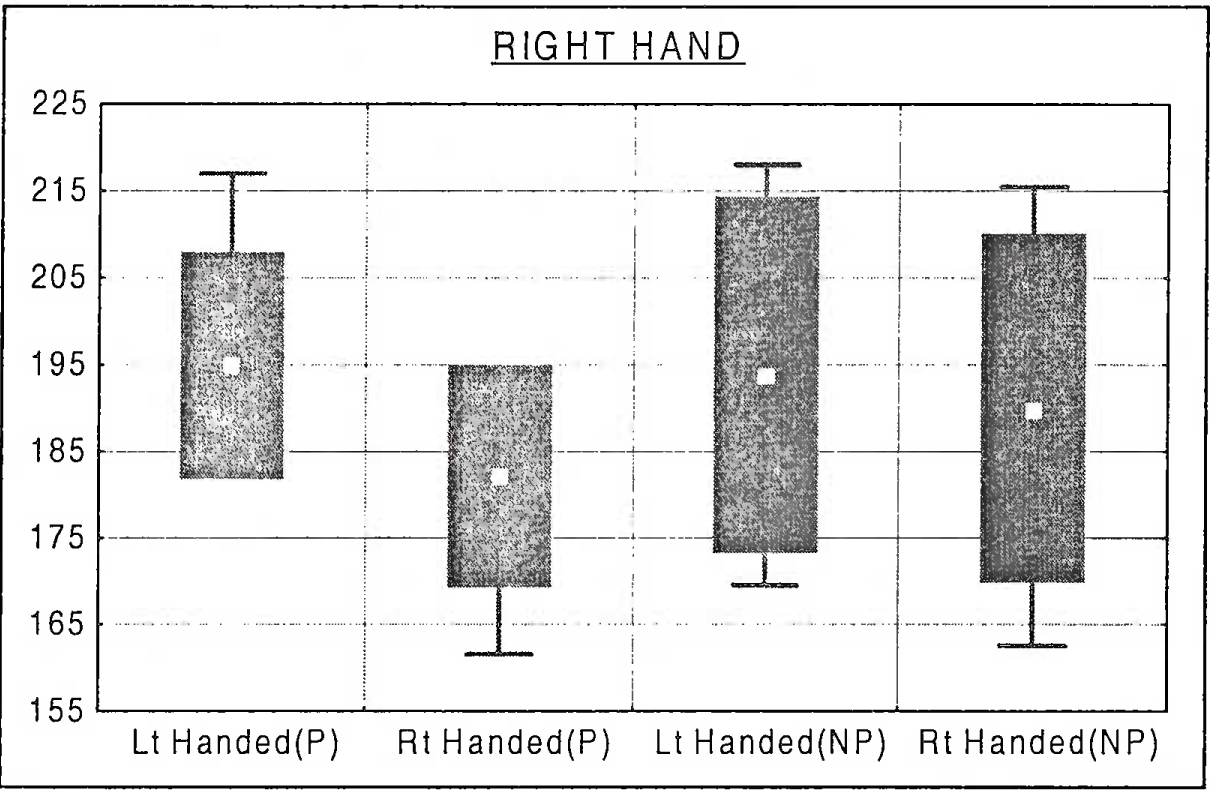
- Time scores in seconds of the Right-Handed Non-Pilot for Right hand in the Finger Dexterity Test
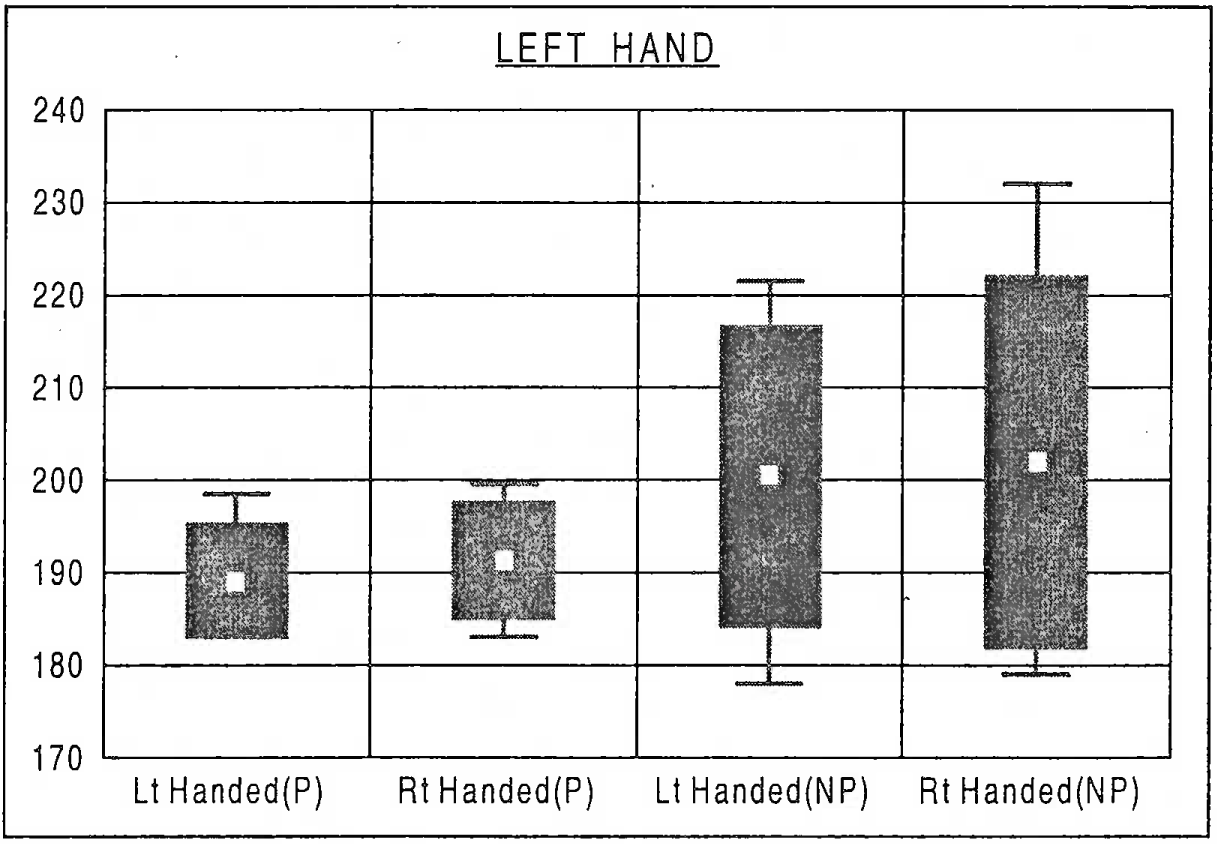
- Time scores in seconds of the Right-Handed Non-Pilot for Left hand in the Finger Dexterity Test
| Subjects | Total | % |
|---|---|---|
| Highly lateralized (Left) | 3 | 1.17 |
| Highly lateralized (Right) | 185 | 71.98 |
| Less lateralized (Left & right) | 69 | 26.85 |
| Total | 257 | 100.00 |
Discussion
The Left-handers are in a minority in any population. Living in a world apparently designed for the right-handers, the left-handers are constantly accommodating and learning to cope with the “right-handed” tools and workplaces. For this reason, in the performance of most routine tasks, they perform as well as the right-handers. That they may be facing difficulty in achieving optimum performance, especially in situations requiring high levels of skill, is not apparent. It is not certain whether the left-handers are compromised by their special attribute. This could be as they are few in numbers, and implication of left-handedness as a contributing factor in incidents or accidents is rare. That left-handers are at a disadvantage requires to be demonstrated by controlled studies. Such studies would be based on tests of eye hand coordination in simulated flying environment. In this study, performance of left and right-handers was assessed using a Psychomotor Rig having controls for both hands and also by using two standard tests for manual dexterity.
The Psychomotor Rig presents controls akin to that present in a conventional cockpit. The scores of this test are related to the degree of coordination achieved by the subject, in the use of both hands simultaneously, in the execution of a task. The mean scores achieved by the lefthanders were as good as that achieved by the right-handers. This was against the expectation that left-handed individuals would score significantly lower than the right-handed. This implied that in the two-hand coordination task there was no compromise because of handedness of the subject. These findings were in agreement with Leon [4] who had reported that movements in one limb were not affected by actions in the other limb. It may be for similar reasons that in multi-crew cockpits of transport and passenger aircraft, pilots have not reported any difficulty in operating controls at either the left or right seat even though the layout of the controls is a “mirror image”.
MRMT was a test of eye-hand and arm-hand coordination. It consisted of a primary task carried out by the hand under test and a secondary task assisted by the other hand. Though performed by both hands, the time score was attributed to the hand carrying out the primary task. The time score was inversely related to the performance. It was expected that the performance scores with the dominant hand would be higher than that with the non-dominant hand. This was not found in this study. It was also expected that the left (dominant) hand of the left-hander would be equal in performance to the right (dominant) hand of the right-hander. This was found to be so. The time scores achieved by the left hand were marginally different from that scored by the right hand in all four groups. These differences were not statistically significant. This led to the inference that there is no difference between the dominant and non-dominant hands in performance of tasks requiring eye-hand and arm-hand coordination. It was also revealed that amongst the right-handed, the scores obtained by the left hand (non-dominant) were slightly better than that obtained by the right (dominant) hand in both pilots and non-pilots. In contrast, amongst the left-handers, in both the pilots and non-pilots, this trend was not present. This variation is not taken into consideration, as it is not statistically significant. Inconsistencies in performance with left hand in left-handers have been reported earlier [5, 6]. It was also found that in right-handers the non-dominant was consistently better. The findings in this study are in agreement with studies in past.
The Finger Dexterity Test is used to assess a subject’s fine motor skills. It is performed by one hand and the time score is inversely related to the performance. This test revealed that there was no statistically significant difference between the performance scores of the left and right hands in any of the groups. The results of this study differ with the findings of study done in 2001 that the non right-handers were faster than the right-handers [7], Comparison across the groups revealed significant difference in only one case. The performance by the dominant (right) hand of right-handed pilots was better than non-dominant (right) hand of left-handed pilots. The difference was significant at p< 0.05. This was as expected. Precision of movement is important in the successful execution of fine motor skill. Such a skill is a requisite in the performance of actions related to operate the trim control or switches, which though not directly related to the handling of the primary controls of the aircraft, is still an important part of flying.
The handedness survey covered a total of 257 pilots and found that 19 (7.4 %) were left-handed. This incidence of 7.4 % was within the stated incidence for left-handed individuals in general population. The laterality quotient scores in the survey also revealed the spectrum of laterality. Of the 19 left-handed, 3 were highly lateralized and of the 237 right-handed, 185 were highly lateralized. 69 (26.8 %) pilots were mixed-handed. The relative incidence revealed that 82.4% of the left-handed and 21.9% of the right-handed were mixed-handed. The survey also revealed that the score of only one person was such that he could be considered as ambidextrous. Similar incidence of left-handedness in the general population, and also in the pilot population, lead to the inference that there is no bias in the flying environment against left-handers. Apparently the selection process and the flying training do not discriminate against the left-handers.
The analysis of the laterality quotient gives interesting results. 16 of the 19 left-handers had varying degrees of mixed handedness while only 52 out of the 237 right-handers had this trait. Percentage wise, this trait of being less lateralized was remarkably higher in the left-handers (84.2 % vs 21.9 %); a finding similar to the one reported by Crowley [8]. This may be because the lefthanders learn to use their non-dominant hand while living in the world “apparently designed for the right-hander.” It also leads us to think that nature endows the left-handers with mixed handedness as 84.2 % of them were in this category. Studies have probed whether mixed handedness is a natural trait or is acquired [9], Same study stated that the incidence of left-handedness decreases with age and has implied that the left-handers learn to acquire skills with their right hands as part of the process of growing up. That the left-handers learn to use the non-dominant more than the right-handers is evident from the relative percentages of incidence (82.4 % in left-handers vs. 21.9 % in the right-handed). This may explain why the left-handed do as well as their right-handed counterparts in all fields including flying as the incidence of left-handers in the sampled pilots was found to be no different from that of the general population. This is in consonance with the findings of earlier studies on the impact of handedness on flying training, and no bias against the left-handers was found [1],
Conclusion
In this study the hand dexterity was assessed in Right and Left-Handed aircrew and non-aircrew using laboratory models. The non-aircrew were included to represent the normal population. The results revealed that in two-hand coordination and eye-hand coordination tasks and also in hand dexterity tasks the left-handed aircrew was not at a disadvantage. This favored the view that there was no bias against left-handers in the conventional cockpit. The handedness survey revealed that the incidence of the left-handers in aviators was the same as that in the general population strengthening the view that there is no bias against the left-hander in flying selection or training. A spectrum of laterality was observed and the relative incidence of mixed handedness was found to be more in the left-handed.
References
- Left handedness and laterality in pilots In: Evrard E, Bergerett P, Van Wulfften Palthe PM, eds. Medical aspects of flight safety. New York: Pergamon; 1959. p. :262-272. In : AGARD NATO
- [Google Scholar]
- Handedness as a predictor of success in helicopter pilot training. Minor Project of the USAF residency in Aerospace Medicine 1988
- [Google Scholar]
- The assessment and analysis of handedness: The Edinburgh Handedness. Neuropsychologia. 1971;9:97-113.
- [Google Scholar]
- Interactions between limbs during bimanual voluntary activity. Brain. 1970;93:259-272.
- [Google Scholar]
- The relation between the hand preference and performance of individual finger movements by left and right hands. Brain. 1970;93:769-774.
- [Google Scholar]
- The relationship between handedness and fine motor performance. Cortex. 2001;37:493-500.
- [Google Scholar]
- Cerebral laterality and handedness in aviation: Performance and selection implications. :95. USAF School of Aerospace Medicine, Human systems division (AFSC) Brooks Air Force base Texas
- Experimental techniques in human Neuropsychology. 1986;2:15-40. In:
- [Google Scholar]






